* Walter Gieseking(5th Nov. 1895~26th Oct. 1956)
[ I want to listen the beautiful sound from my piano ]
 3 Walter Gieseking(photo ; Fayer,
Wien)
3 Walter Gieseking(photo ; Fayer,
Wien)
Though EMI is
without doubt the representative record company from the
1900s to 1960s, sometimes I am angry when EMI's piano
recordings, especially in 1950s. So bad sounds with so
great pianists! I read an article that an ex-EMI
staff confessed in a book, "Most of the EMI's
recordings were done by the old machines used from 78s
era in 1950s. Therefore, in the 1950s, the recording quality of EMI
was something to be desired."
(something... or much?)
Considering this, naturally, EMI's piano
recordings are not good compared to the recording
year(tone color of piano is difficult to catch, really!).
Only in my personal opinion, even the piano recordings in
1930s by EMI are generally better than in 1950s, only
judging from piano tone (of course, if neglecting the
surface noises). Due to such an old machines, it should
perhaps be Walter Gieseking's recordings that tend to be
most undervalued. His 'fantastic tone like crystals' does not exist in most of his EMI
records.
Walter Gieseking
was born at Lyon, France. However, both of his parents
are German, and his nationality also Germany. At young
age his lesson was given to him by mother. Formal lesson
was began after moving Hannover where was mother's
homeland. At the municipal conservatory, he was tutored
by Karl Leimer, who was very famous for his systematic
pedagogy. Even before Hannover times, he was said to play
Schumann's Fantasy publicly, but the beginning of the
formal lesson at 16-year-old is more or less late
compared to other famous pianists. However, only five
years later he debuted at Hannover by Liszt's Concerto
No.1 and toured Europe after WWI. His first roll
recording was in 1922 and first American trip begun on
22nd Feb. 1922 gave him international fame. Paris debut
was on 1928. Especially his performances of the French
impressionists became famous soon, and even the
criticizers against him acclaimed his Debussy and Ravel
unanimously.
Peoples want to know why he did not
exile from Nazi regime. Though he was at a distance from
voluntary Nazi claim, he was banned at podium to early
1948 and had to cancel the American tour at 1949 season
because of the demonstration of the American veterans. He
was able to tour USA only in 1953, and on the spring of
1956 toured again for two month. Most of the critics were
for him in this last American tour.
Because his ability of memorizing piano
score was incredibily great, his concert schedule was
such a busy one that he should move from here to there
always. It was natural that he should have himself
enrolled to traffic accident two times. The first seemed
to be not serious, but the later one in 1955 was so big
that he lost his wife on the spot and that he was
misreported to be killed by a German paper. They said he
would not be able to play again, but luckily he recovered
perfectly to the next year and was able to tour America
again at spring. However, (due to the aftereffects of
such a busy schedule?) on October in a session of
Beethoven's complete sonatas in EMI's no.3 studio at
Abbey Road, he fell by severe stomachache. Though
emergently operated, he passed away on 26th October. The
cause of death was acute pancreatitis(this disease occurs
when the enzimes of pancreas digest pancreas itself. It
is far more danger than we can imagine. Several thousands
die of this a year in USA). His last session was held on
17~22nd October, in which 10 Beethoven's sonatas and
Chopin's Barcarolle and Berceuse were
recorded.
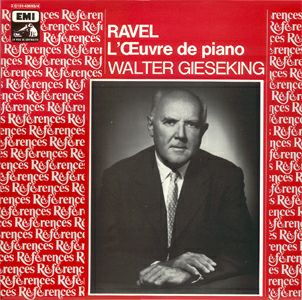 If
you'd like to know how Gieseking thought about music, Modernes Klavierspiel(Modern
piano playing) should be the best window. It was written by him and his teacher Karl
Leimer, of which preface was written by Gieseking. He
said "I am unconditionally loyal to the
method of Leimer, though twelve years have passed since I
learned." The contents of this book can be
considered as his route of learning.
If
you'd like to know how Gieseking thought about music, Modernes Klavierspiel(Modern
piano playing) should be the best window. It was written by him and his teacher Karl
Leimer, of which preface was written by Gieseking. He
said "I am unconditionally loyal to the
method of Leimer, though twelve years have passed since I
learned." The contents of this book can be
considered as his route of learning.
Leimer stresses 'intense training of
ear' in this book, which includes the training of
listening the playing of one's own - breeding the ability
of the objective decision of rhythm, tone color, and
tempi(and etc.) of his own performances. Exquisite
and through nuances were one of his characteristic
factor, which was based on his trained ear. Leimer said
in this book "Gieseking's Debussy and Ravel are
unanimously acclaimed as the world-best by critics all
over the world, which
results from the skillful mastering of all kinds of touch
and nuances".
Moreover, it is mentioned to memorize score
by concentration and to expand the repertoire, which
Gieseking's memorizing ability and vast repertoire result
from. Bartok and Heinrich
Neuhaus (teacher of Sviatoslav
Richter and Emil
Gilels) are said to have considerable memorizing ability
of score, but I guess Gieseking was next to no other
contemporaries. An episode: Concert at evening - a score
of a newly composed work was received - reading it in
train - playing the work next evening by memorizing! It
was said that he did not practice too much, which I can
understand enough considering his transcendent technique
and memorizing ability. It is interesting that we can
find mistakes when listening his record with reading
scores. Sometimes they are not mere mistouch but wrong
memorizing; it was legendary, but not '100% perfect'.
As you can imagine his
style from above, his music can be abbreviated as 'pure,
simple and precise style, keen insight, and full spectrum
of nuances'. Since one of his
main purpose of playing was to exactly reconstruct a
score, arbitrarily exaggeration cannot be found. But his
tone color was beyond imagination - audiences and critics
unanimously said his tone color was superior to any other
pianist in subtleness and exquisiteness in Gieseking's
peak times(1920~30s) - really transparent and beautiful.
Mozart's lieder(1955 stereo) is one of the most renowned
recordings of Schwarzkopf and him, in which the piano
sound is very round, soft, and individual in spite that
he did not use the right pedal much. It is said that he
never selected the piano maker in concert(very often.
Horowitz conveyed his Steinway piano for any
concerts), which is impossible unless he was totally
confident in his technique and touch.
Dean Elder, who was apprentice of Gieseking,
contributed a chapter named 'Gieseking's Debussy and
Ravel performances' to Joseph Banowetz's very good book The
pianist's guide to pedaling. He said about
Gieseking's tone "Transparent, not percussive, with very large
dynamic range". He told
Gieseking to say "I should listen the beautiful
sound from my piano", which I really agree to if it
was said by Gieseking. His Ravel and Debussy will be not
the only way but very refined one in his way
really. Dean Elder explains Gieseking's intention
comparing to the records, which is very precious archive
as it is nearly unprecedented that the intention of such
a great virtuoso remains with his record and explanation.
The chapter explains why Gieseking's pedalings are so
long compared to his contemporaris in records.
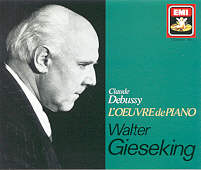 Gieseking's
recordings are many though considering the era, but as I
said above, unfortunately there are not many that capture
his tone well. Of course EMI should be blamed, contracted
with him in tape era; moreover EMI introduced the stereo
technique from 1953~4, but most of Gieseking's 1955~6
recordings exist only by monaural. After 1955, Decca and
RCA switched to stereo in the most sessions; EMI is
uncomparable to them. Even Elisabeth Schwarzkopf, who was
unquestionably one of the representative artist of EMI
and wife of the leader of EMI's sessions, once complained
about the sluggish behavior of EMI(Walter Legge hated
stereo). More bad thing is irregular sound qualities of
his recordings; Mozart's lied with Schwarzkopf(1955,
stereo), Mendelssohn's Songs without words(1956,
monaural), and Schubert's Impromptus(1955, monaural) each
has pretty different sound quality. Mendelssohn was the
latest recording but instable sound(EMI international's
references release has better sound than Japanese HS-2088
issue, but I can listen a trace of the problem at the
former). These trend are also found at Debussy and Ravel
recordings.
Gieseking's
recordings are many though considering the era, but as I
said above, unfortunately there are not many that capture
his tone well. Of course EMI should be blamed, contracted
with him in tape era; moreover EMI introduced the stereo
technique from 1953~4, but most of Gieseking's 1955~6
recordings exist only by monaural. After 1955, Decca and
RCA switched to stereo in the most sessions; EMI is
uncomparable to them. Even Elisabeth Schwarzkopf, who was
unquestionably one of the representative artist of EMI
and wife of the leader of EMI's sessions, once complained
about the sluggish behavior of EMI(Walter Legge hated
stereo). More bad thing is irregular sound qualities of
his recordings; Mozart's lied with Schwarzkopf(1955,
stereo), Mendelssohn's Songs without words(1956,
monaural), and Schubert's Impromptus(1955, monaural) each
has pretty different sound quality. Mendelssohn was the
latest recording but instable sound(EMI international's
references release has better sound than Japanese HS-2088
issue, but I can listen a trace of the problem at the
former). These trend are also found at Debussy and Ravel
recordings.
In spite of these problems, his Debussy
and Ravel set are worth while to being listened. Debussy
was recorded in 1953~55, and Ravel in 1954. Both have
relatively a bit fast tempo, and showed his individual
sonority well - if we should imagine it to some extent!
Judging from my Japanese old release of Debussy, it has
considerably unsatisfactory sound quality compared to
Casadesus' Debussy by USA Columbia. Ravel set is a bit
better, as far as I can say by listening my Pathe
References LP since the international CD was released
only on 2001. These two sets will show 'the
excessiveness' of the most new recordings available.
Philips's 20th century pianist series release(now
unavailable) included Debussy and Ravel recorded in
1930s, and I want to listen the tone color of his peak
time.
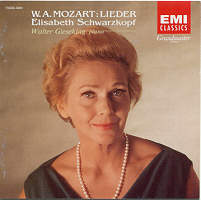 He was
also famous as a specialist of Mozart. His complete set
of Mozart are often recommended but many of my musical
friends say it is NOT the best at the present time as far
as Pires's(DG) are in catalog, moreover due to sound
quality and 8CDs by med-price! I'd like to recommend
Lieder with Schwarzkopf(1955 stereo). Originally 17 works
were recorded but all of the international issues 16
works without K.518 (I guess the reason is that K.518 has
inferior sound quality to others). It is one of the best
sound quality in his records. However, two drawbacks
of this record are that Schwarzkopf's technique is
excessive(! ^^) and that the works themselves are not so
better than those after Schubert's. Concertos with
Rosbaud and Karajan are Nos. 20,23~25, and quintet with
Philharmonia winds ensemble(perhaps now unavailable). I
think concertos are not with first recommendable priority
because there are many recordings with good sound and
performance by others.
He was
also famous as a specialist of Mozart. His complete set
of Mozart are often recommended but many of my musical
friends say it is NOT the best at the present time as far
as Pires's(DG) are in catalog, moreover due to sound
quality and 8CDs by med-price! I'd like to recommend
Lieder with Schwarzkopf(1955 stereo). Originally 17 works
were recorded but all of the international issues 16
works without K.518 (I guess the reason is that K.518 has
inferior sound quality to others). It is one of the best
sound quality in his records. However, two drawbacks
of this record are that Schwarzkopf's technique is
excessive(! ^^) and that the works themselves are not so
better than those after Schubert's. Concertos with
Rosbaud and Karajan are Nos. 20,23~25, and quintet with
Philharmonia winds ensemble(perhaps now unavailable). I
think concertos are not with first recommendable priority
because there are many recordings with good sound and
performance by others.
The three composers are worth while to
being recommended af first. I have heard 5 sonatas of
Beethoven, but they are not universal in the point of
tempo(too fast!). Other sonatas by radio recordings were
released by Tahra, including 27 works. Concerto Nos. 4
and 5 did two times at EMI studio(with Karajan monaural
and Galliera stereo), and wartime stereo recording with
Rother by German tape technique released by Music &
Arts. Other composer's works are more eminent than
Beethoven. Mendelssohn's Song without words and
Grieg's Lyric pieces (though sound quality is
problematic) are one of the best seller, released by
References series and now available. With Karajan and
Philharmonia, Schumann, Grieg, and Franck's work were
left. 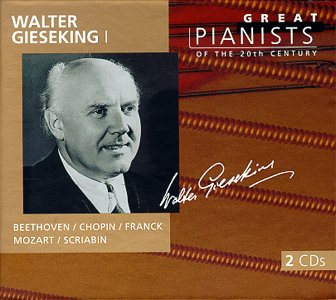 Schubert's Impromptus is very good. Moment
musicaux, 3 pieces, Brahms' pieces, and Schumann's
Carnaval and Kinderscenen was recorded, but
most of them are not available by international
version(available only by Japanese).
Schubert's Impromptus is very good. Moment
musicaux, 3 pieces, Brahms' pieces, and Schumann's
Carnaval and Kinderscenen was recorded, but
most of them are not available by international
version(available only by Japanese).
When I am listening Gieseking's record, it reminds me of a sentence in the Leimer's book. "When I hear my student playing, I think he(or she) feels same to me about the work." Leimer's method of teaching is very modern and rational even from the present viewpoint, but I loathe such a loss of the individuality in music. How different he was from Leschetizky - all of his students had developed personalized different styles - and Neuhaus, whose style was once called 'generous indifference' to his students(of course from his student's view. Neuhaus was far from 'indifference' to his students. Otherwise, Richter would not appreciate him)! I dare to guess Leimer could not bring up a pianist greater than Gieseking. And, I do want to give a tribute to him who had ability that can not be absorbed but absorb Leimer's method as his style.
4 Gieseking, Philips Great Pianists Series I ; from Amazon
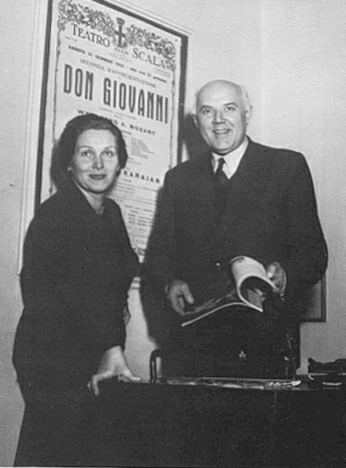 |
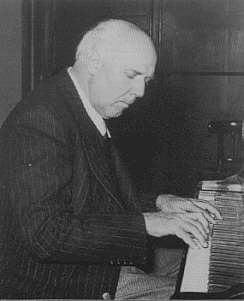 |
| 5 at La Scala, Milano, with Elisabeth Schwarzkopf | 5 In practising |
 |
 |
| 5 Gieseking's hands(1) | 5 Gieseking's hands(2) |
Links/Resources
- R.W.Krause's Walter Gieseking page ; Brief discography
- Great Pianists page ; Short commentary about Gieseking's characteristics
- A review of Schumann/Debussy/Ravel ; Released by BBC Classics
- Photo from ; Ravel's complete works(EMI Références LP C151-43093/4), Mendelssohn/Grieg(EMI CHS 5 66775 2), Mozart lieder(EMI Références LP 1015781)
- Gieseking's life ; liner note of 'The Art of Walter Gieseking', Toshiba-EMI TOCE 8131~36(6 CD set)
- Joseph Banowetz, The pianist's guide to pedaling, Indiana University Publishing, 1985 (Korean Translation; Eumak Choonchoo)
(c) 2000~ , Youngrok LEE ; Link free, but please get my approval before you reuse, copy, or quote this materials.
Created ; 11th Mar. 2006
(Korean version
created ; 1st Oct. 2000)